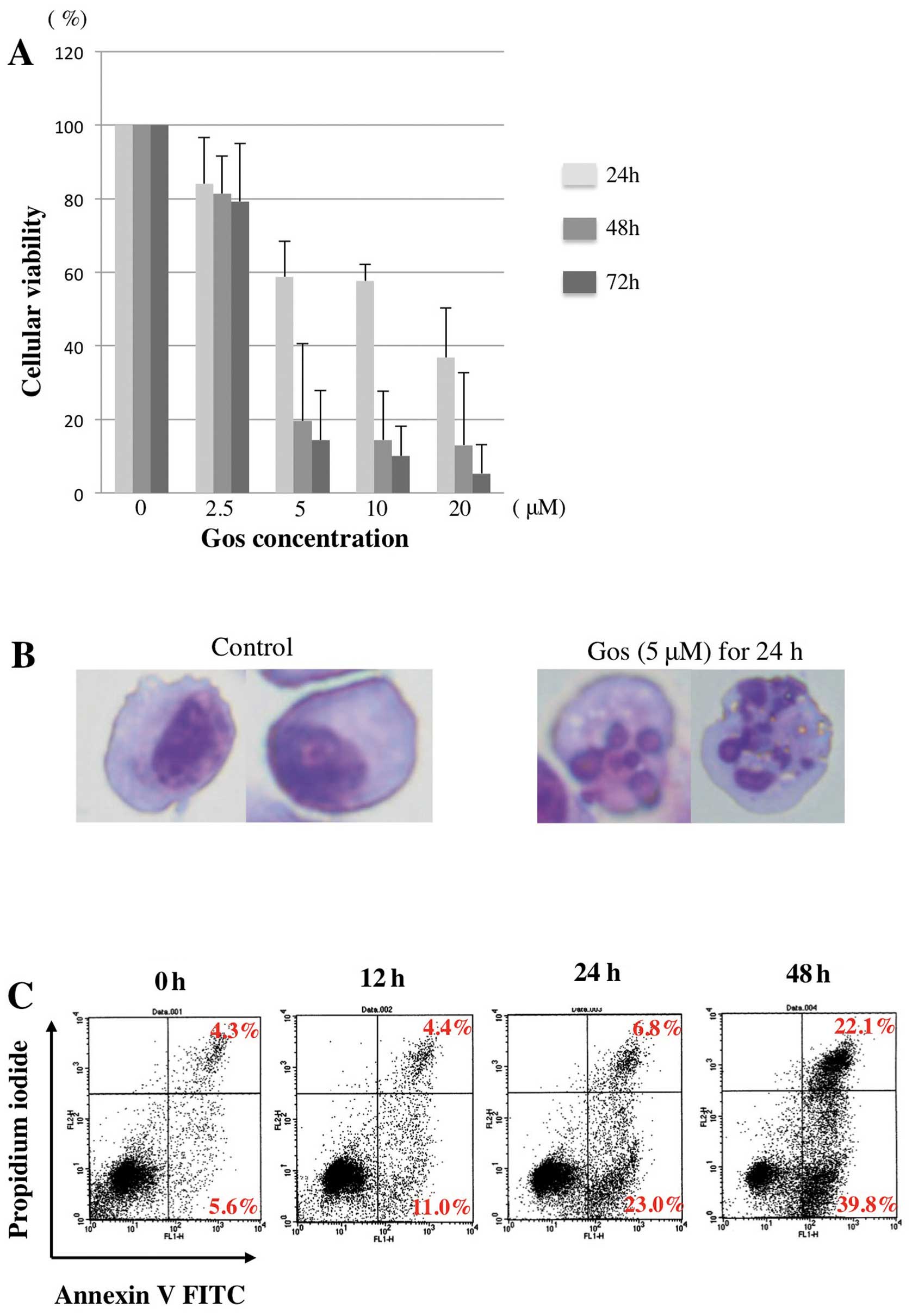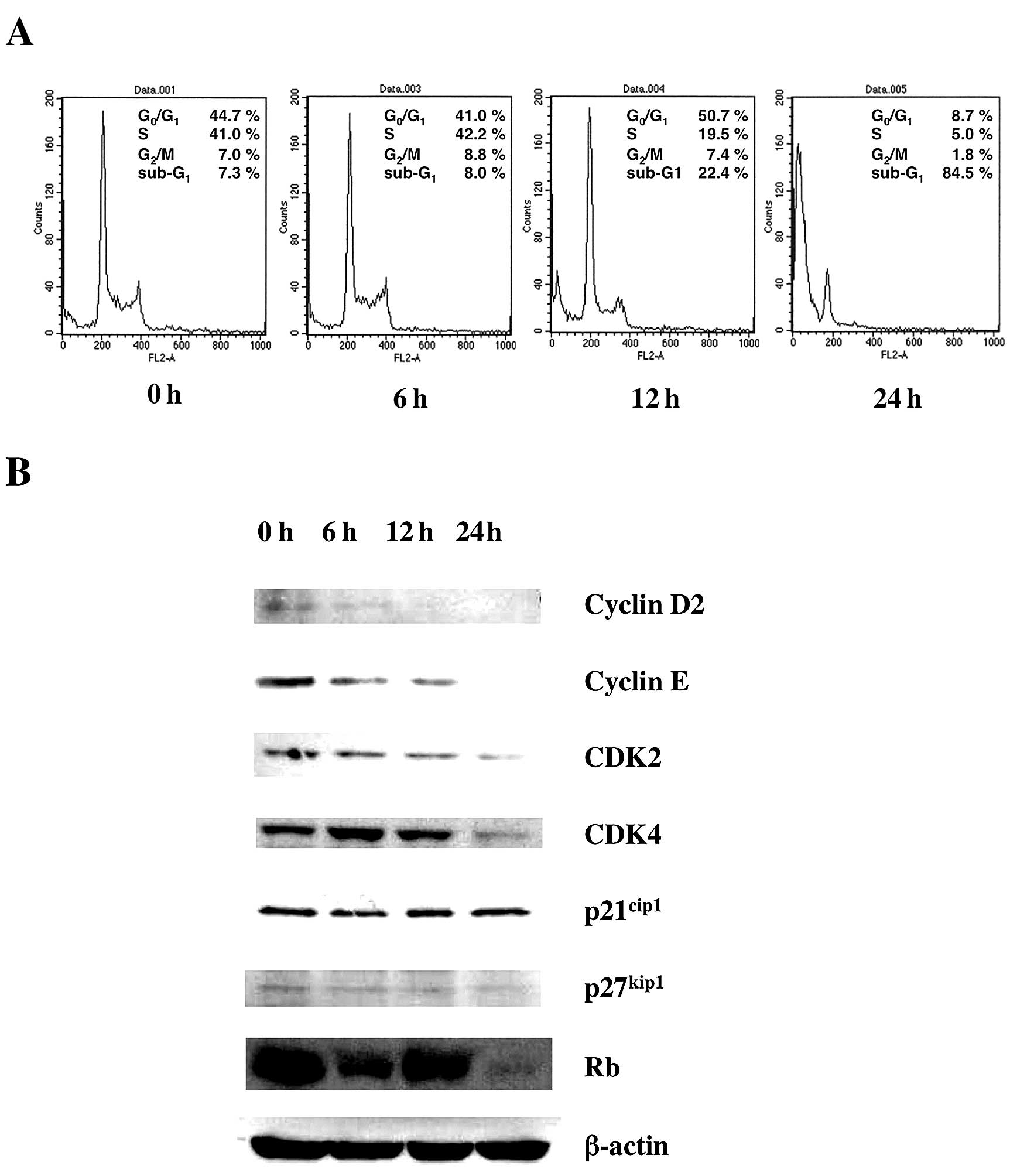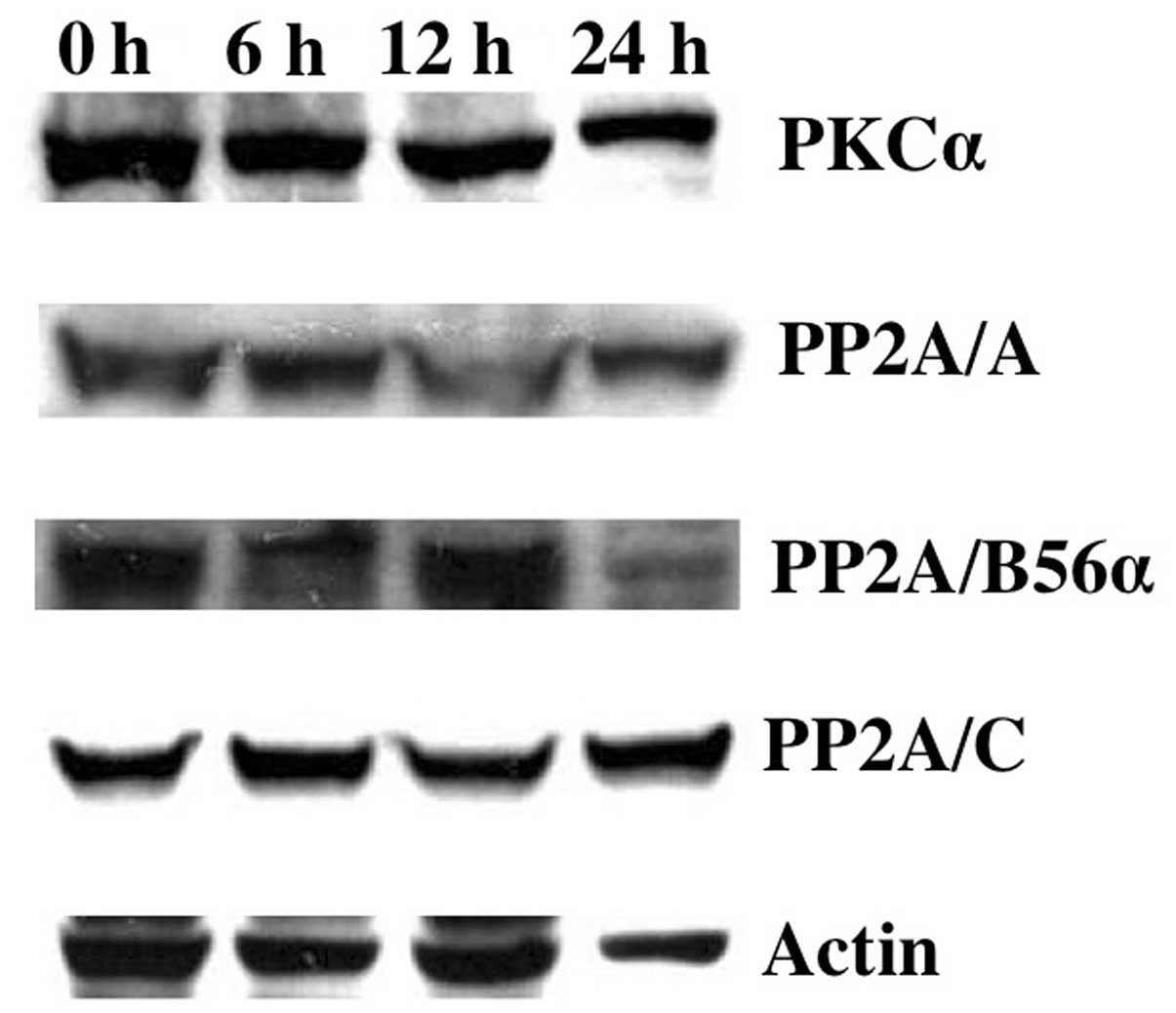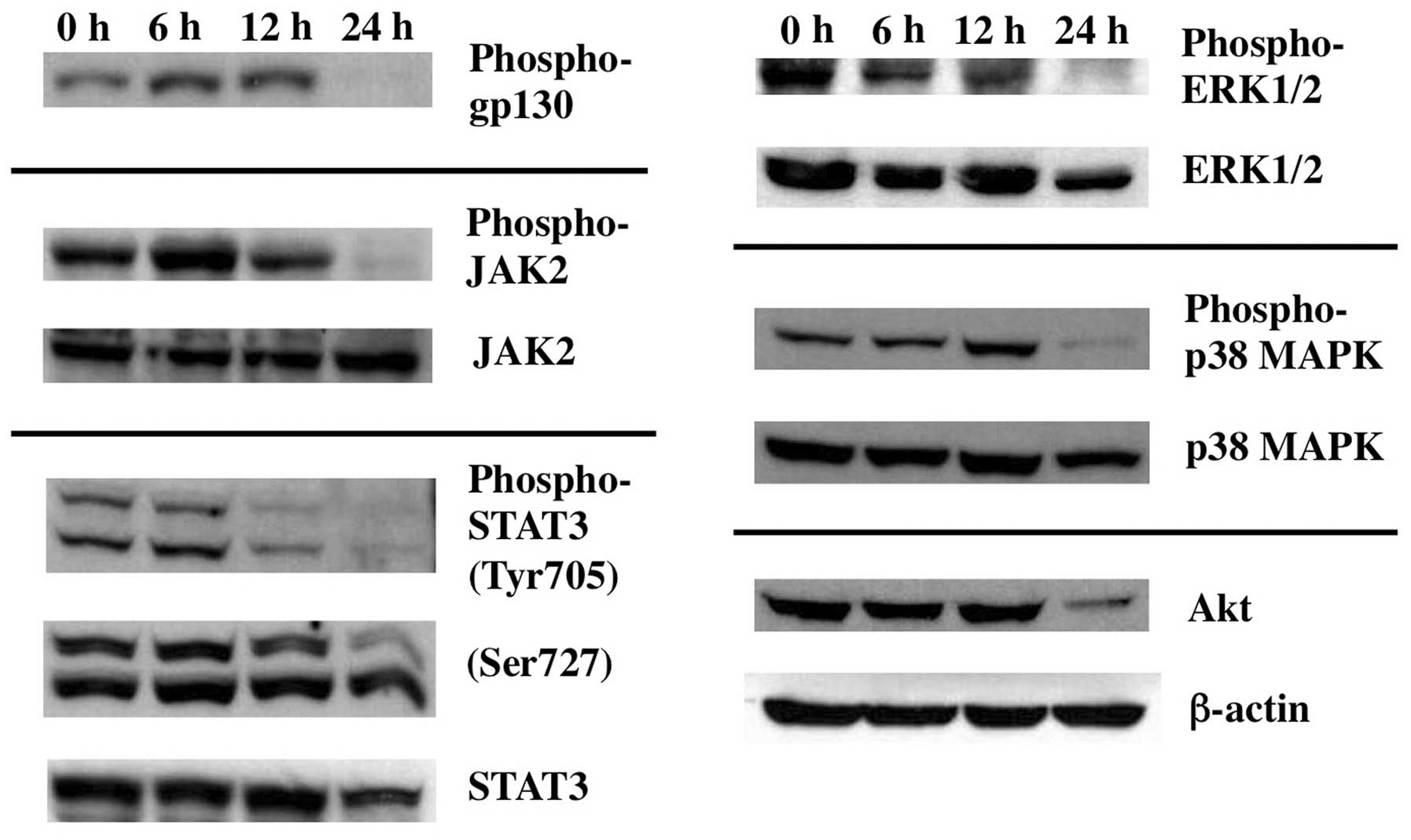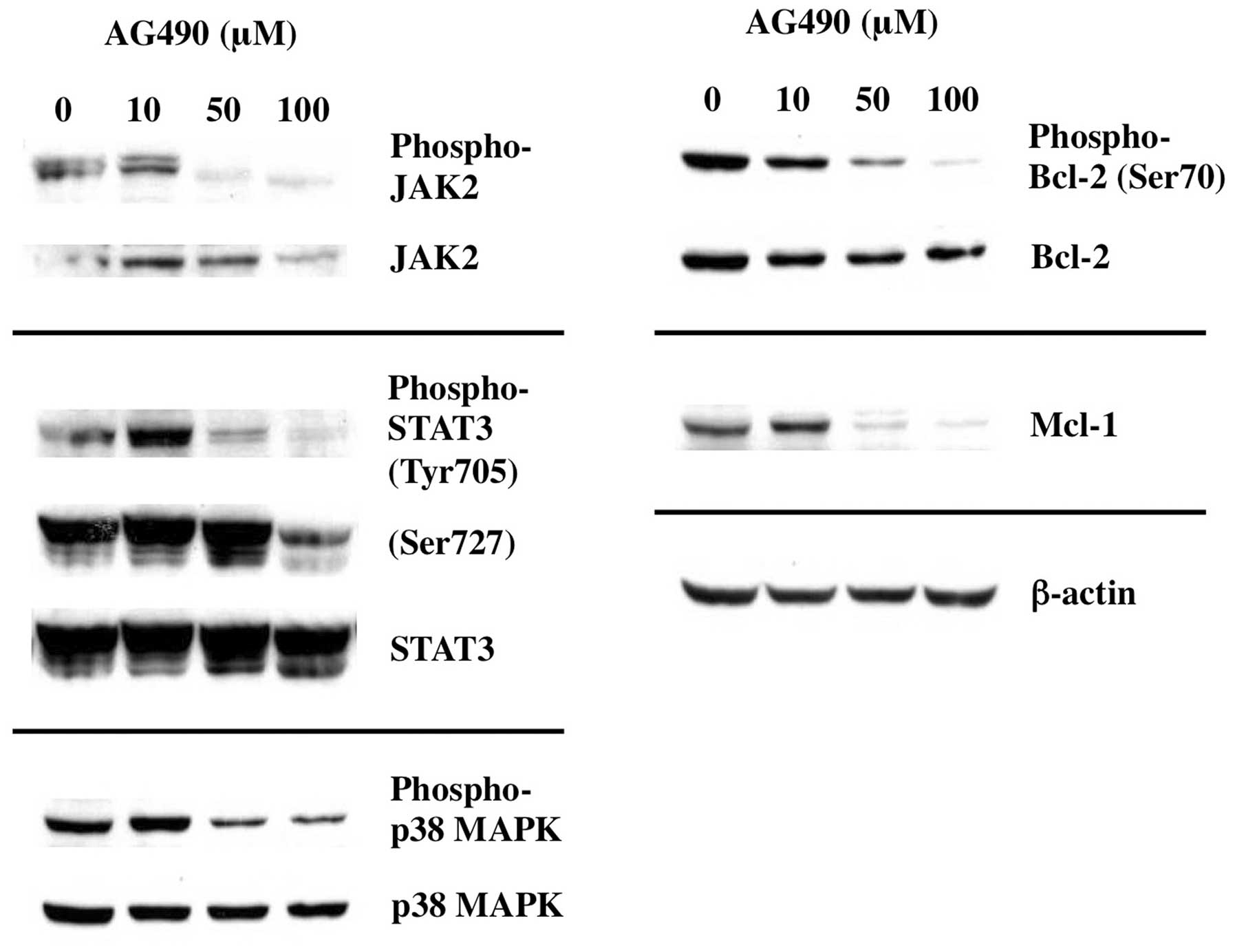|
1
|
Hideshima T and Anderson KC: Molecular
mechanisms of novel therapeutic approaches for multiple myeloma.
Nat Rev Cancer. 2:927–937. 2002. View
Article : Google Scholar : PubMed/NCBI
|
|
2
|
Hideshima T, Bergsagel PL, Kuehl WM and
Anderson KC: Advances in biology of multiple myeloma: clinical
applications. Blood. 104:607–618. 2004. View Article : Google Scholar : PubMed/NCBI
|
|
3
|
Pettersson M, Jernberg-Wiklund H, Larsson
LG, et al: Expression of the bcl-2 gene in human multiple myeloma
cell lines and normal plasma cells. Blood. 79:495–502.
1992.PubMed/NCBI
|
|
4
|
Oancea M, Mani A, Hussein MA and Almasan
A: Apoptosis of multiple myeloma. Int J Hematol. 80:224–231. 2004.
View Article : Google Scholar
|
|
5
|
van de Donk NW, Bloem AC, van der Spek E
and Lokhorst HM: New treatment strategies for multiple myeloma by
targeting BCL-2 and the mevalonate pathway. Curr Pharm Des.
12:327–340. 2006.PubMed/NCBI
|
|
6
|
Guo S, Zhi Y, Yang H, et al: Bcl-2
expression is associated with poor prognosis of solitary
plasmacytoma of bone. Ann Hematol. 93:471–477. 2013. View Article : Google Scholar : PubMed/NCBI
|
|
7
|
Kridel R, Sehn LH and Gascoyne RD:
Pathogenesis of follicular lymphoma. J Clin Invest. 122:3424–3431.
2012. View
Article : Google Scholar : PubMed/NCBI
|
|
8
|
Bende RJ, Smit LA and van Noesel CJ:
Molecular pathways in follicular lymphoma. Leukemia. 21:18–29.
2007. View Article : Google Scholar : PubMed/NCBI
|
|
9
|
Weyhenmeyer B, Murphy AC, Prehn JH and
Murphy BM: Targeting the anti-apoptotic Bcl-2 family members for
the treatment of cancer. Exp Oncol. 34:192–199. 2012.PubMed/NCBI
|
|
10
|
Juin P, Geneste O, Gautier F, Depil S and
Campone M: Decoding and unlocking the BCL-2 dependency of cancer
cells. Nat Rev Cancer. 13:455–465. 2013. View Article : Google Scholar : PubMed/NCBI
|
|
11
|
Shamas-Din A, Kale J, Leber B and Andrews
DW: Mechanisms of action of Bcl-2 family proteins. Cold Spring Harb
Perspect Biol. 5:a0087142013. View Article : Google Scholar : PubMed/NCBI
|
|
12
|
Ola MS, Nawaz M and Ahsan H: Role of Bcl-2
family proteins and caspases in the regulation of apoptosis. Mol
Cell Biochem. 351:41–58. 2011. View Article : Google Scholar : PubMed/NCBI
|
|
13
|
Tsujimoto Y: Cell death regulation by the
Bcl-2 protein family in the mitochondria. J Cell Physiol.
195:158–167. 2003. View Article : Google Scholar : PubMed/NCBI
|
|
14
|
Kang MH and Reynolds CP: Bcl-2 inhibitors:
targeting mitochondrial apoptotic pathways in cancer therapy. Clin
Cancer Res. 15:1126–1132. 2009. View Article : Google Scholar : PubMed/NCBI
|
|
15
|
Keshmiri-Neghab H and Goliaei B:
Therapeutic potential of gossypol: an overview. Pharm Biol.
52:124–128. 2014. View Article : Google Scholar : PubMed/NCBI
|
|
16
|
Wang X, Howell CP, Chen F, Yin J and Jiang
Y: Gossypol - a polyphenolic compound from cotton plant. Adv Food
Nutr Res. 58:215–263. 2009. View Article : Google Scholar : PubMed/NCBI
|
|
17
|
Lopez LM, Grimes DA and Schulz KF:
Nonhormonal drugs for contraception in men: a systematic review.
Obstet Gynecol Surv. 60:746–752. 2005. View Article : Google Scholar : PubMed/NCBI
|
|
18
|
Oliver CL, Bauer JA, Wolter KG, et al: In
vitro effects of the BH3 mimetic, (-)-gossypol, on head and neck
squamous cell carcinoma cells. Clin Cancer Res. 10:7757–7763. 2004.
View Article : Google Scholar : PubMed/NCBI
|
|
19
|
Stein RC, Joseph AE, Matlin SA, Cunningham
DC, Ford HT and Coombes RC: A preliminary clinical study of
gossypol in advanced human cancer. Cancer Chemother Pharmacol.
30:480–482. 1992. View Article : Google Scholar : PubMed/NCBI
|
|
20
|
Le Blanc M, Russo J, Kudelka AP and Smith
JA: An in vitro study of inhibitory activity of gossypol, a
cottonseed extract, in human carcinoma cell lines. Pharmacol Res.
46:551–555. 2002.PubMed/NCBI
|
|
21
|
Kapoor S: Attenuating effect of gossypol
on tumor growth in systemic malignancies. Cell Biochem Biophys.
67:1551–1552. 2013. View Article : Google Scholar : PubMed/NCBI
|
|
22
|
Xu P, Ye W, Jen R, Lin SH, Kuo CT and Lin
YC: Mitogenic activity of zeranol in human breast cancer cells is
enhanced by leptin and suppressed by gossypol. Anticancer Res.
29:4621–4628. 2009.PubMed/NCBI
|
|
23
|
Anderson MA, Huang DC and Roberts AW: BH3
mimetic therapy: an emerging and promising approach to treating
chronic lymphocytic leukemia. Leuk Lymphoma. 54:909–911. 2013.
View Article : Google Scholar : PubMed/NCBI
|
|
24
|
Voss V, Senft C, Lang V, et al: The
pan-Bcl-2 inhibitor (-)-gossypol triggers autophagic cell death in
malignant glioma. Mol Cancer Res. 8:1002–1016. 2010. View Article : Google Scholar : PubMed/NCBI
|
|
25
|
Meng Y, Tang W, Dai Y, et al: Natural BH3
mimetic (-)-gossypol chemosensitizes human prostate cancer via
Bcl-xL inhibition accompanied by increase of Puma and Noxa. Mol
Cancer Ther. 7:2192–2202. 2008. View Article : Google Scholar : PubMed/NCBI
|
|
26
|
Volate SR, Kawasaki BT, Hurt EM, et al:
Gossypol induces apoptosis by activating p53 in prostate cancer
cells and prostate tumor-initiating cells. Mol Cancer Ther.
9:461–470. 2010. View Article : Google Scholar : PubMed/NCBI
|
|
27
|
Huang LH, Hu JQ, Tao WQ, et al: Gossypol
inhibits phosphorylation of Bcl-2 in human leukemia HL-60 cells.
Eur J Pharmacol. 645:9–13. 2010. View Article : Google Scholar : PubMed/NCBI
|
|
28
|
Czabotar PE, Lessene G, Strasser A and
Adams JM: Control of apoptosis by the BCL-2 protein family:
implications for physiology and therapy. Nat Rev Mol Cell Biol.
15:49–63. 2013. View
Article : Google Scholar : PubMed/NCBI
|
|
29
|
Ruvolo PP, Deng X and May WS:
Phosphorylation of Bcl2 and regulation of apoptosis. Leukemia.
15:515–522. 2001. View Article : Google Scholar : PubMed/NCBI
|
|
30
|
Deng X, Kornblau SM, Ruvolo PP and May WS
Jr: Regulation of Bcl2 phosphorylation and potential significance
for leukemic cell chemoresistance. J Natl Cancer Inst Monogr.
30–37. 2001.PubMed/NCBI
|
|
31
|
Tamura Y, Simizu S and Osada H: The
phosphorylation status and anti-apoptotic activity of Bcl-2 are
regulated by ERK and protein phosphatase 2A on the mitochondria.
FEBS Lett. 569:249–255. 2004. View Article : Google Scholar : PubMed/NCBI
|
|
32
|
Sahin F, Avci CB, Gunduz C, Sezgin C,
Simsir IY and Saydam G: Gossypol exerts its cytotoxic effect on
HL-60 leukemic cell line via decreasing activity of protein
phosphatase 2A and interacting with human telomerase reverse
transcriptase activity. Hematology. 15:144–150. 2010. View Article : Google Scholar
|
|
33
|
Heinrich PC, Behrmann I, Haan S, Hermanns
HM, Muller-Newen G and Schaper F: Principles of interleukin
(IL)-6-type cytokine signalling and its regulation. Biochem J.
374:1–20. 2003. View Article : Google Scholar : PubMed/NCBI
|
|
34
|
Catlett-Falcone R, Landowski TH, Oshiro
MM, et al: Constitutive activation of Stat3 signaling confers
resistance to apoptosis in human U266 myeloma cells. Immunity.
10:105–115. 1999. View Article : Google Scholar : PubMed/NCBI
|
|
35
|
Subramanian M and Shaha C: Up-regulation
of Bcl-2 through ERK phosphorylation is associated with human
macrophage survival in an estrogen microenvironment. J Immunol.
179:2330–2338. 2007. View Article : Google Scholar
|
|
36
|
Puthier D, Bataille R and Amiot M: IL-6
up-regulates Mcl-1 in human myeloma cells through JAK/STAT rather
than ras/MAP kinase pathway. Eur J Immunol. 29:3945–3950. 1999.
View Article : Google Scholar : PubMed/NCBI
|
|
37
|
Puthier D, Derenne S, Barille S, et al:
Mcl-1 and Bcl-xL are co-regulated by IL-6 in human myeloma cells.
Br J Haematol. 107:392–395. 1999. View Article : Google Scholar : PubMed/NCBI
|
|
38
|
Wuilleme-Toumi S, Robillard N, Gomez P, et
al: Mcl-1 is over-expressed in multiple myeloma and associated with
relapse and shorter survival. Leukemia. 19:1248–1252. 2005.
View Article : Google Scholar : PubMed/NCBI
|
|
39
|
Zhang B, Gojo I and Fenton RG: Myeloid
cell factor-1 is a critical survival factor for multiple myeloma.
Blood. 99:1885–1893. 2002. View Article : Google Scholar : PubMed/NCBI
|
|
40
|
Derenne S, Monia B, Dean NM, et al:
Antisense strategy shows that Mcl-1 rather than Bcl-2 or Bcl-x(L)
is an essential survival protein of human myeloma cells. Blood.
100:194–199. 2002. View Article : Google Scholar : PubMed/NCBI
|
|
41
|
Ihle JN, Thierfelder W, Teglund S, et al:
Signaling by the cytokine receptor superfamily. Ann NY Acad Sci.
865:1–9. 1998. View Article : Google Scholar : PubMed/NCBI
|
|
42
|
Nakashima K and Taga T: gp130 and the IL-6
family of cytokines: signaling mechanisms and thrombopoietic
activities. Semin Hematol. 35:210–221. 1998.PubMed/NCBI
|
|
43
|
Lin J, Wu Y, Yang D and Zhao Y: Induction
of apoptosis and antitumor effects of a small molecule inhibitor of
Bcl-2 and Bcl-xl, gossypol acetate, in multiple myeloma in
vitro and in vivo. Oncol Rep. 30:731–738.
2013.PubMed/NCBI
|



